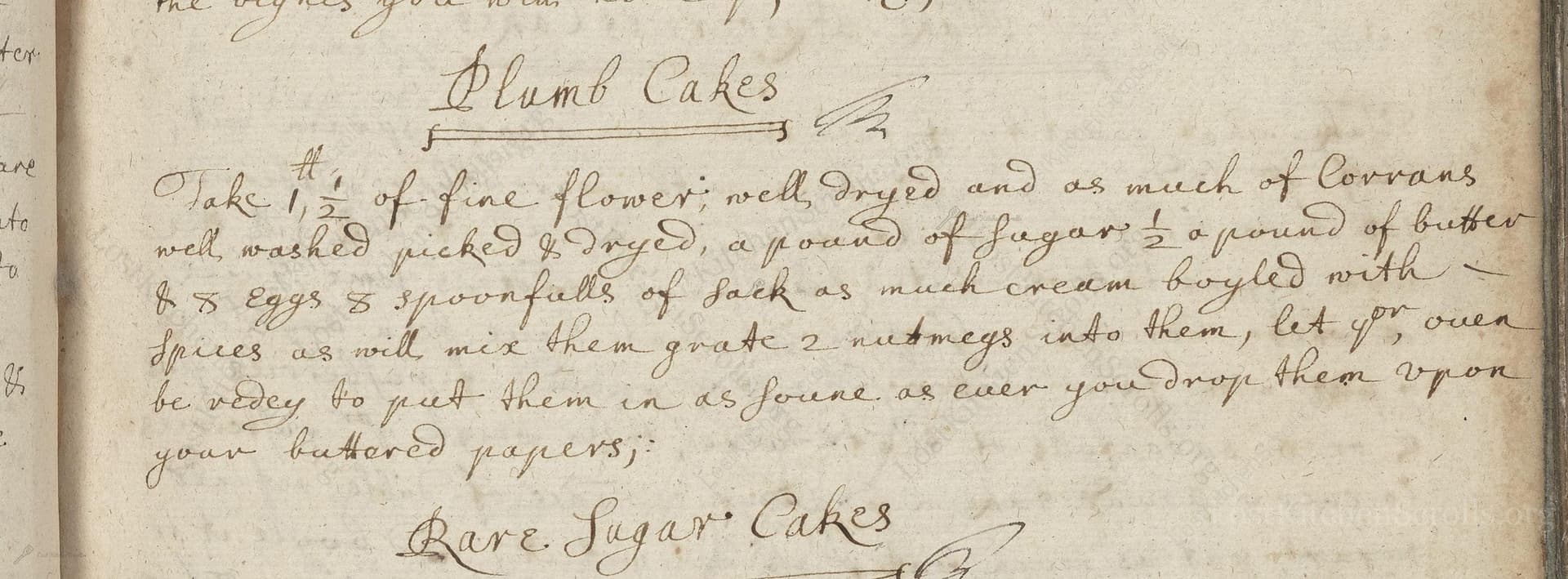Plumb Cakes
From the treasured pages of Cookbook of Jane Dawson
Written by Jane Dawson

Plumb Cakes
"Take 1/2 of fine flower; well dryed and as much of Corrans well washed picked & dryed, a pound of Sugar 1/2 a pound of butterr & 8 eggs & Spoonfulls of Sack as will mix them grated 2 nuttmegs Spices as will mix them grate 2 nuttmegs into them, let yr oven be redey to put them in as soone as ever you drop them vpon your butterred papers;"
Note on the Original Text
Early modern English recipes, like this one, are written in a shorthand both practical and personal. Measurements are approximate, relying on the cook's judgment ('as much as will mix'), and units are either weight-based (pound, half-pound) or by eye and experience (a spoonful). Spelling varies: 'flower' for 'flour', 'Corrans' for 'currants', and 'nuttmegs' for 'nutmegs.' The recipe assumes the reader has sufficient experience to know about oven temperatures, batter consistency, and cooking times—all left unwritten yet understood by its original audience.

Title
Cookbook of Jane Dawson (1690)
You can also click the book image above to peruse the original tome
Writer
Jane Dawson
Era
1690
Publisher
Unknown
Background
A delightful glimpse into late 17th-century English kitchens, Jane Dawson's recipe collection is a flavorful tapestry of sweet delicacies and savory dishes, revealing the tastes and ingenuity of bygone home cooks.
Kindly made available by
Folger Shakespeare Library
This recipe is drawn from the late 1600s, found in Jane Dawson's manuscript recipe collection. At the time, 'plumb cakes' referred not only to cakes made with plums, but to any cake enriched with dried fruit, particularly currants or raisins. These treats were luxurious—sweet, fragrant, and enriched with expensive imported spices and alcohol, more accessible in wealthy English households. Sack wine, an early sherry, was synonymous with festivity and special occasions. Written at a time when baking was often done in wood-fired ovens, such recipes reflect both the resourcefulness and extravagance of English households in the Stuart period, a window into the domestic life and flavors of the time.

Historically, this batter would have been mixed in large, heavy earthenware bowls using wooden spoons or hands. Eggs were beaten by hand, sometimes in a dedicated bowl or even a pan. The dough was spooned onto sheets of thick, hand-cut paper, greased with butter. Baking occurred in a brick or stone oven, heated with wood and carefully managed for an even baking temperature. There were no modern timers or thermostats—cooks gauged readiness by color and smell, and needed skill to produce a consistent result.
Prep Time
20 mins
Cook Time
20 mins
Servings
12
We've done our best to adapt this historical recipe for modern kitchens, but some details may still need refinement. We warmly welcome feedback from fellow cooks and culinary historians — your insights support the entire community!
Ingredients
- 2 cups plain flour (well dried or sifted)
- 1 1/2 cups currants (washed, picked over, and thoroughly dried)
- 1 cup caster sugar
- 1/2 cup (1 stick) unsalted butter
- 8 large eggs
- 2 tablespoons (1 fl oz) sherry (substitute for Sack wine)
- 2 whole nutmegs, grated
- 1–2 teaspoons mixed baking spices (cinnamon, cloves, optional)
Instructions
- To recreate these delightful 17th-century Plumb Cakes, begin by preheating your oven to 350°F (180°C).
- Take 2 cups of plain flour, thoroughly sifted, and mix with 1 1/2 cups of currants (well washed and dried).
- Add 1 cup of caster sugar and 1/2 cup (1 stick) of unsalted butter, softened.
- Whisk 8 large eggs together, and gradually incorporate them into the mix.
- Add 2 tablespoons (about 1 fl oz) of sherry (as a modern substitute for Sack, a sweet fortified wine).
- Grate in two whole nutmegs and, if you like, a pinch of mixed baking spices (such as cinnamon and cloves).
- Combine all ingredients until a soft, spoonable batter forms.
- Line a baking tray with buttered baking paper.
- Drop generous spoonfuls of mixture onto the tray, leaving space for spreading.
- Bake for 15–20 minutes, or until lightly golden.
- Enjoy warm or cool.
Estimated Calories
320 per serving
Cooking Estimates
It takes about 20 minutes to prepare the ingredients and 20 minutes to bake the cakes. Each serving has about 320 calories, and you will get 12 small cakes from this recipe.
As noted above, we have made our best effort to translate and adapt this historical recipe for modern kitchens, taking into account ingredients nowadays, cooking techniques, measurements, and so on. However, historical recipes often contain assumptions that require interpretation.
We'd love for anyone to help improve these adaptations. Community contributions are highly welcome. If you have suggestions, corrections, or cooking tips based on your experience with this recipe, please share them below.
Join the Discussion
Rate This Recipe

Den Bockfisch In Einer Fleisch Suppen Zu Kochen
This recipe hails from a German manuscript cookbook compiled in 1696, a time whe...

Die Grieß Nudlen Zumachen
This recipe comes from a rather mysterious manuscript cookbook, penned anonymous...

Ein Boudain
This recipe comes from an anonymous German-language manuscript cookbook from 169...

Ein Gesaltzen Citroni
This recipe, dating from 1696, comes from an extensive anonymous German cookbook...
Browse our complete collection of time-honored recipes



